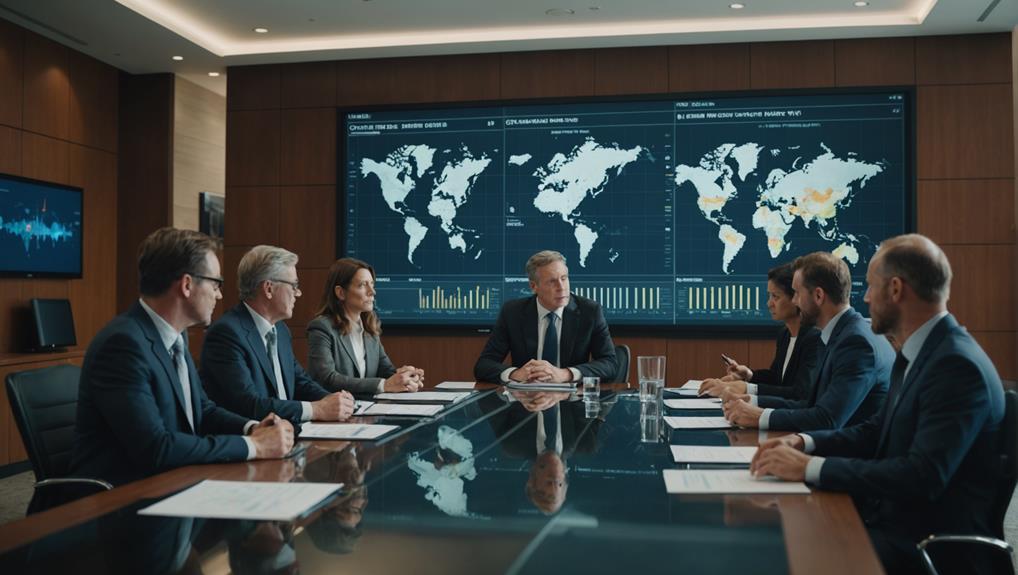Building a Unified Leadership Structure in Mergers and Acquisitions

Creating a unified leadership structure is crucial in mergers and acquisitions to ensure a seamless transition and sustainable success. This entails establishing a leadership team early on, merging leaders from both organizations, and setting up transparent communication channels.
Emphasizing talent retention through mentorship and development, while enhancing skills for blending cultures and reaching consensus, is key. Prioritizing inclusion and diversity is essential for building trust and driving innovation.
Leveraging data-driven cultural insights can help align values and establish a shared vision, promoting cohesion and growth in the merger. Proactive strategies to address M&A challenges can further enhance operational efficiency.
By implementing these strategies, leadership cohesion can be strengthened to drive growth and success in the merged entity.
Key Takeaways
- Establishing a unified leadership team from the outset is crucial to drive alignment and collaboration in mergers and acquisitions.
- Transparent decision-making processes are essential to foster trust and mutual understanding among team members.
- Embracing cultural sensitivity and inclusivity can help merge diverse perspectives effectively and create a harmonious work environment.
- Tailoring leadership development programs to enhance resilience and essential skills can contribute to the success of the integration process.
- Maintaining clear communication channels is key to building trust and streamlining the overall integration efforts.
Early Formation of Leadership Team
Establishing a unified leadership team early in the M&A process is crucial for fostering transparent and inclusive decision-making. This early collaboration ensures that key decision-makers from both merging entities come together, promoting a culture of collaboration and mutual understanding. By setting clear objectives and expectations at the outset, we can drive alignment towards organizational goals.
Integrating leaders from both organizations in the initial stages of the merger is essential for creating a cohesive culture. This blend of leadership styles paves the way for a harmonious collaboration that respects and combines different leadership approaches. Not only does this unity help prevent potential conflicts, but it also sets a positive tone for the entire organization.
Involving the leadership team from the beginning promotes transparency and ensures that all perspectives are valued. This inclusive approach is vital for fostering innovative thinking, as it harnesses diverse viewpoints to solve complex issues. Prioritizing the early formation of a unified leadership team lays a solid foundation for a successful merger, where strategic decisions are made with a shared vision and purpose.
Integrating Cultural Sensitivity
To create a cohesive leadership structure in mergers and acquisitions, it's essential to recognize and embrace cultural diversity while fostering an inclusive environment that values a wide range of perspectives.
By incorporating these unique cultural aspects at the outset of the M&A process, we establish a solid foundation for effective teamwork and solidarity.
This emphasis on cultural sensitivity not only promotes transparency but also cultivates a peaceful and efficient post-merger environment.
Appreciating Cultural Differences
Recognizing and appreciating cultural differences is crucial for the successful integration of teams in mergers and acquisitions. It isn't just a nice gesture but a vital requirement for the process. Leadership development plays a key role in this aspect. Cultivating leaders who excel at building trust and fostering cultural integration is essential. This involves acknowledging and respecting the distinct values, norms, and behaviors that each organization brings to the table.
Integrating these cultural nuances paves the way for a smoother transition and lays a strong foundation for a unified leadership structure. This approach not only improves collaboration but also creates an environment where innovative ideas can thrive. When leaders embrace diverse perspectives and practices, they create a more inclusive and dynamic workplace.
Establishing trust among diverse teams is of utmost importance. Aligning our leadership cultures to create a seamless blend that supports our shared goals is essential. Appreciating cultural differences goes beyond just avoiding conflicts; it's about harnessing diversity to drive success. By doing so, we set the stage for a harmonious post-merger period, ensuring the overall success of the integration process.
Fostering Inclusive Environment
By incorporating an understanding of cultural nuances, we can create an inclusive environment that's conducive to effective leadership practices.
In the context of mergers and acquisitions, prioritizing cultural sensitivity becomes crucial for enhancing employee retention rates and streamlining integration processes. The establishment of an inclusive atmosphere fosters a sense of belonging among team members, leading to improved collaboration and stronger team cohesion, which are essential for a seamless transition.
Recognizing and valuing the diversity of organizational cultures plays a pivotal role in aligning leadership styles, thus promoting a harmonious workplace environment. This alignment sets the stage for a cooperative post-merger strategy, laying the groundwork for a successful transition. By building trust through cultural sensitivity, we establish a solid foundation for productivity and unity within the newly merged entity.
As leaders, it's imperative to integrate cultural sensitivity into our practices by actively acknowledging and appreciating the various perspectives present within the new organizational culture. This approach not only nurtures trust but also encourages innovative thinking, which is crucial for driving the merged organization towards progress. By fostering inclusivity, we empower all team members to leverage their unique strengths, thereby creating a dynamic and resilient organization poised for sustained success.
Ensuring Clear Communication

Effective communication plays a crucial role in mergers and acquisitions to ensure that leadership teams are aligned and integration runs smoothly. By establishing transparent communication channels, we can build trust and foster collaboration within our integrated leadership structure. It's essential to ensure that key decision-makers from both organizations are in sync to avoid any misunderstandings and promote a cohesive approach towards shared objectives.
Promptly addressing concerns through open lines of communication is vital to maintaining alignment and reducing uncertainty among our leadership ranks. Creating an environment where worries can be openly discussed and resolved helps in keeping the team focused on the common goals. Regular updates and open dialogue within the leadership team are key to ensuring organizational goal alignment and strategic clarity.
In the fast-paced business environment of today, innovation thrives on effective communication. Prioritizing clear and consistent communication sets the stage for a unified and agile leadership team capable of navigating the complexities of mergers and acquisitions. This proactive approach not only helps in achieving immediate goals but also paves the way for sustained success and innovation in the future.
Let's make communication the cornerstone as we work towards building a unified leadership structure that can adapt and thrive in a dynamic business landscape.
Strategies for Talent Retention
As we emphasize the importance of clear communication, it is vital to concentrate on effective strategies for retaining our top talent to ensure stability and continuity after the merger. Retention strategies play a critical role in maintaining leadership stability during the transformation process. One way to achieve this is by implementing mentorship programs and providing professional development opportunities to enhance talent retention and demonstrate support for our leaders.
A valuable approach is to offer clear career paths and growth opportunities within the newly integrated organization. This not only addresses any uncertainties among leadership ranks but also fosters a sense of belonging and future prospects. Furthermore, proactively addressing leadership concerns can help prevent attrition, thus preserving the strength of our leadership team.
To exemplify these strategies, the table below summarizes key talent retention approaches:
| Retention Strategy | Description |
|---|---|
| Mentorship Programs | Matching leaders with mentors for guidance and support |
| Professional Development | Providing training and opportunities for growth |
| Clear Career Paths | Mapping out advancement routes within the new organization |
| Addressing Leadership Concerns | Proactively managing issues and ensuring stability |
| Regular Feedback and Communication | Maintaining ongoing dialogue to resolve issues effectively |
Leadership Development Programs

Tailored leadership development programs play a crucial role in navigating post-M&A challenges effectively.
These programs focus on enhancing collaboration and decision-making skills, preparing our leaders to tackle integration complexities with resilience and agility.
Tailored Skill Enhancement
Tailored leadership development programs provide leaders with the essential skills required to address the distinct challenges of a post-merger setting. These programs focus on integration, ensuring that our leadership teams can effectively navigate the complexities inherent in mergers and acquisitions (M&A).
Customized to suit the specific requirements of the newly merged entity, these initiatives play a crucial role in promoting collaboration and facilitating sound decision-making.
Our approach to enhancing leadership skills is both strategic and innovative. We concentrate on three key areas to facilitate a smooth transition:
- Integration Competencies: Leaders are trained to blend diverse corporate cultures, align organizational objectives, and establish a cohesive vision for the newly formed entity.
- Collaborative Decision-Making: Our training emphasizes inclusive leadership and consensus-building to ensure that all perspectives are considered during critical decision-making processes.
- Resilience Building: Programs are designed to boost leaders' adaptability and emotional intelligence, enabling them to navigate the inevitable uncertainties of the post-merger environment effectively.
These customized programs are tailored to address the unique dynamics of each merger, ensuring that our leadership teams not only survive the M&A process but thrive, driving growth and fostering a unified organizational culture.
Post-Merger Leadership Resilience
Following a merger, our leadership development initiatives are designed to cultivate resilience within the newly integrated leadership team, enabling them to effectively address the unique challenges that arise post-merger. By providing our leaders with essential skills and tools, we enhance their ability to collaborate, make informed decisions, and improve overall team performance, which are crucial for navigating the complexities of M&A success.
Creating a cohesive leadership structure goes beyond simply merging roles; it involves fostering a unified team dynamic that incorporates our new colleagues. Our programs underscore the significance of resilience, ensuring that our leaders are equipped to steer the organization through the transition and into the future. This preparedness is vital for maintaining stability and fostering growth during the critical post-merger period.
Investing in leadership development is an investment in our organization's future. By strengthening our leadership capabilities, we increase the likelihood of a successful post-merger integration. Leadership resilience programs play a pivotal role in this endeavor, driving the overall success of the combined entity by establishing a stable and growth-focused environment.
Through these initiatives, our goal is to construct a robust leadership framework that can adapt to change, surmount obstacles, and guide us towards sustained success. The outcome is a unified, resilient leadership team poised to lead our organization to new heights.
Importance of Inclusion and Diversity
Why are inclusion and diversity crucial in ensuring a successful merger and acquisition? By creating an environment where everyone feels valued, we can establish trust, improve teamwork, and achieve cultural harmony. These aspects are vital for building a cohesive and efficient leadership structure after a merger.
Prioritizing inclusion helps prevent the harmful 'us versus them' mindset that often arises during mergers. When leadership teams embrace inclusive practices, they're better equipped to maintain trust and facilitate smoother transitions. Here are three key advantages:
- Increased Retention Rates: Inclusion cultivates a sense of belonging, resulting in higher employee retention and lower turnover rates.
- Improved Collaboration: Diverse teams bring a range of perspectives, driving innovation and effective problem-solving.
- Seamless Cultural Integration: Inclusion efforts ensure a smoother alignment of cultures, aiding in the seamless integration of policies and practices.
Neglecting diversity and inclusion can lead to decreased productivity, diminished morale, and higher turnover. Conversely, embracing these principles during mergers promotes significant cultural integration, establishing a foundation for a harmonious post-merger environment.
Let's prioritize inclusion and diversity to ensure that our mergers aren't only successful but also sustainable and innovative.
Addressing M&A Challenges

Addressing the intricate challenges of mergers and acquisitions demands a proactive approach, especially in integrating diverse cultures and ensuring operational efficiency. As we navigate these complex waters, our leadership plays a crucial role in steering the ship towards successful integration.
Thorough due diligence is essential, not only financially but also culturally, to pinpoint potential friction points early on.
Inadequate integration strategies often result in reduced productivity, low morale, and increased attrition rates. Prioritizing the swift integration of acquired teams is key to achieving synergy and operational effectiveness. This involves steering away from an 'us versus them' mindset and instead promoting a unified approach that values diverse perspectives.
A valuable lesson we've learned is that the success of integration relies on the speed and quality of our efforts. By promptly aligning our operational processes and leadership structures, we can minimize cultural clashes and uphold high morale. Our role as leaders is to ensure that every team member feels included and appreciated, fostering productivity and innovation.
Ultimately, tackling these challenges head-on with a strategic and inclusive mindset is crucial to unlocking the full potential of any merger or acquisition.
Promoting Cultural Fit
To promote cultural fit in mergers and acquisitions, it's crucial to evaluate the cultural compatibility by understanding the core values, behaviors, and working styles of the involved entities.
By integrating a diverse range of perspectives, organizations can create a harmonious environment that enhances employee engagement and retention.
Prioritizing cultural alignment leads to a significant boost in productivity, fosters innovation, and ultimately drives overall business success.
Assessing Cultural Compatibility
Assessing the cultural fit in mergers involves closely examining the alignment of values, beliefs, and behaviors between the merging companies. This evaluation is crucial to ensure a smooth integration of organizational structures and leadership approaches. By assessing cultural compatibility, potential conflicts and areas for synergy can be identified, leading to a more harmonious merger.
To effectively evaluate cultural alignment, it's essential to focus on key areas:
- Organizational Structures: Understanding how the structures of each company support or impede collaboration can reveal whether a seamless merger is feasible or if significant adjustments are needed.
- Leadership Styles: Examining the prevalent leadership approaches in both organizations helps in predicting the functionality of the new leadership team.
- Communication Methods: Analyzing how employees communicate within and between teams can highlight potential sources of friction or opportunities for improved collaboration.
Assessing these aspects is critical in ensuring a successful merger where cultural alignment supports the integration process and fosters a cohesive organizational culture.
Integrating Diverse Perspectives
Integrating diverse perspectives in a merger enriches our capacity to form a cohesive and adaptable leadership team. By incorporating varied viewpoints, we ensure a well-rounded approach to problem-solving and strategic planning during the post-merger phase.
Fostering cultural alignment goes beyond merging operational structures; it involves harmonizing leadership values, behaviors, and decision-making styles to nurture seamless collaboration. Acknowledging and appreciating cultural subtleties within the combined entity fosters inclusivity and a culture of mutual respect, essential for a united team.
To establish a unified leadership framework, it's crucial to recognize and harness the strengths of leaders from both merging organizations. This approach promotes a shared vision of organizational objectives, fostering alignment and synergy within the leadership cohort. Embracing diverse perspectives enables us to access a wider array of ideas and solutions, bolstering our ability to adapt and persevere in the face of challenges.
Cultural compatibility serves as the cohesive force that unites our leadership team, ensuring a shared understanding of the company's vision and mission. Through this concerted effort, we can cultivate a dynamic, innovative, and future-ready organization poised for sustained success in an ever-evolving market.
Best Practices for Inclusion

To ensure a seamless integration process during mergers and acquisitions, it's crucial to prioritize cultural nurturing. New leadership should align roles and expectations to foster a supportive environment for all team members. Cultural nurturing enables the identification of potential disparities in values and practices, leading to a unified approach from the outset.
To enhance a sense of belonging and improve retention rates, consider the following strategies:
- Facilitate Open Conversations: Encourage discussions on HR practices and cultural values to bridge gaps and foster trust among team members.
- Provide Support Coaches: Offering coaches and operational training can help team members adapt quickly and feel supported throughout the transition.
- Encourage Unified Communication: Promoting the adoption of a common workplace language can improve communication and unity, reinforcing the concept of one cohesive team.
Inclusion initiatives have a significant impact on employee morale, client relationships, and organizational cohesion. By committing to these best practices, organizations can ensure that all team members feel valued and engaged, setting the stage for a successful merger.
Prioritizing intentional cultural nurturing and proactive measures can lead to smooth integration and long-term success.
Utilizing DEI Resources
Expanding on our commitment to fostering a culturally inclusive environment, let's delve into how utilizing DEI resources can bolster a cohesive leadership structure during mergers and acquisitions. At West Monroe, we understand the significance of diverse perspectives and the positive impact they've on nurturing an inclusive workplace. Our Women in Mergers & Acquisitions Group and Pan-Asian Employee Network exemplify our dedication to promoting diversity and inclusion within our organization.
These resources go beyond mere compliance; they actively combat biases and champion diversity, ensuring that every individual's voice is respected and appreciated. This proactive approach is particularly vital during mergers and acquisitions, where the successful integration of new team members can significantly influence the outcome of the endeavor. By cultivating a supportive atmosphere, we cultivate a dynamic work environment that fosters innovation.
Opportunities at West Monroe cater to a wide range of individuals, from seasoned professionals to students, all within a framework that fosters growth through an inclusive ethos. Our DEI initiatives are designed to seamlessly incorporate new team members, establishing a cohesive structure that harnesses diverse perspectives to enhance decision-making.
In this way, we guarantee that our leadership framework isn't only cohesive but also enriched by the diverse skills and viewpoints of our team members.
Data-Driven Cultural Insights

To gain crucial cultural insights during mergers and acquisitions, we can conduct employee surveys and analyze HR data. By utilizing tools like the Organizational Culture Assessment Instrument, we gain systematic understanding of the cultural dynamics at play. This data-driven approach enables us to pinpoint common values and appreciate diverse perspectives, leading to smoother integration.
Involving employees in shaping a new organizational narrative holds significance. Their input aids in crafting a unified vision that resonates throughout both organizations.
Ensuring successful cultural integration during M&A entails:
- Employee Surveys: These offer real-time feedback on organizational values and preferences, highlighting areas of alignment.
- HR Data Analysis: Examining metrics such as employee engagement and turnover rates provides a quantitative view of cultural well-being.
- Shared Cultural Values: Utilizing common values identified through data can establish a cohesive approach to merging cultures.
Timing for Value Alignment
Initiating value coherence early in the M&A process significantly increases the likelihood of a successful integration. Establishing clear alignment on values from the beginning sets a solid foundation for the leadership team, ensuring that everyone is in sync even before the merger deal is finalized. Research consistently indicates that early value coherence leads to improved post-merger performance and cultural unity, both of which are vital for long-term success.
Companies that prioritize value coherence at the outset of the M&A process experience smoother transitions and higher levels of employee engagement. This approach fosters the creation of a shared vision and purpose, aligning the goals and expectations of both organizations. By doing so, not only do we cultivate a united leadership team, but we also nurture an environment conducive to innovation.
Timely value coherence serves as a cornerstone for blending diverse corporate cultures, reducing potential conflicts, and leveraging the strengths of each organization. Aligning values early on lays the groundwork for a more cohesive and efficient leadership team capable of guiding the merged entity towards its strategic goals. Consequently, value coherence transcends being merely a step in the M&A process; it becomes a critical strategy for achieving sustained growth and excellence.
Frequently Asked Questions
What Is the Role of Leadership in M&A?
Leadership plays a crucial role in M&A transactions. It is essential for driving success by creating a cohesive team dynamic, implementing innovative communication strategies, and facilitating efficient decision-making processes. These elements help align teams, navigate cultural differences, and maximize synergies post-merger.
Effective leadership in M&A involves inspiring confidence in the team, setting a clear vision for the future, and fostering a collaborative and inclusive work environment. By providing guidance and direction, leaders can ensure that all stakeholders are on the same page and working towards common goals.
Furthermore, strong leadership in M&A transactions is necessary for managing the complexities and challenges that arise during the integration process. Leaders must be able to adapt to changing circumstances, make tough decisions, and maintain a sense of stability and direction amidst uncertainty.
How Do You Structure a Merger and Acquisition?
Let's discuss the process of structuring a merger and acquisition. We begin by focusing on integration planning to ensure a seamless alignment of the organizations involved. This step is crucial for a successful transition and synergy between the merging entities.
Effective communication plays a pivotal role in the merger and acquisition process. By establishing a robust communication strategy, organizations can promote transparency and inclusivity. This fosters an environment of collaboration and innovation, leading to smoother handovers and better overall integration.
In mergers and acquisitions, leadership and management alignment are key factors for success. It is essential for leaders to be on the same page and work towards a common goal to drive the combined entity forward. By prioritizing leadership and management alignment, organizations can navigate the complexities of mergers and acquisitions more effectively.
What Is the Team Structure of Mergers and Acquisitions?
Our M&A team structure prioritizes team cohesion, ensuring that leaders from both organizations work together seamlessly. By blending expertise from both entities, we promote innovation, collaboration, and a smooth integration process. This approach aims to drive success and create a unified corporate culture post-merger.
Why Is Leadership and Culture Important to M&A Success?
Just like a symphony where every instrument plays in perfect harmony, organizational alignment and cultural integration in M&A transactions create a seamless and successful union. When leadership fully supports the merger, employees are engaged, communication is effective, and change management is prioritized, innovation flourishes, ensuring a smooth transition and long-term success.
The importance of leadership and culture in M&A cannot be overstated. Studies have shown that companies with strong leadership and a positive organizational culture are more likely to achieve successful mergers and acquisitions. By aligning leadership strategies and fostering a culture of collaboration and adaptability, companies can navigate the complexities of M&A with confidence and achieve their desired outcomes.
In essence, leadership and culture act as the guiding force behind M&A success, setting the tone for organizational alignment and integration. When leaders prioritize communication, engagement, and change management, they create a foundation for innovation and growth, driving the merger towards a harmonious and prosperous future.
Conclusion
Navigating the merging of two corporate entities involves forming a unified leadership structure, being sensitive to different cultures, and ensuring clear communication. Retaining top talent, fostering leadership development, and anchoring our practices in diversity, equity, and inclusion resources have been our guiding principles.
By leveraging data-driven insights and aligning our values in a timely manner, we've charted a path towards a cohesive and inclusive leadership framework. As the captains of this endeavor, we're committed to steering the ship smoothly towards a horizon of organizational success that's both effective and unified.





